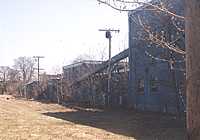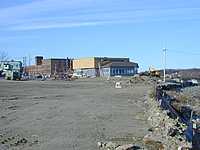Waste Site Cleanup & Reuse in New England
The City of Old Town, ME
Success in EPA-Conducted Targeted Brownfield
Assessments
Old Town, ME
(July 31, 2001)
Contacts
| Before
Redevelopment |
|
 Former Lily-Tulip factory site |
|
| During
Redevelopment |
|
 Construction at factory site |
|
After
Redevelopment |
|
 Commercial building at redeveloped site |
In 1996, a $20,000 EPA-Conducted Targeted Brownfields Assessment (TBA) was carried out at the former Lily-Tulip factory site. Information gained during this assessment was used as a strategic marketing tool to sell the property to developers. The successful transformation of the underutilized contaminated site to a revitalized waterfront park and commercial property was a partnership between the proactive city government of Old Town, the Maine Department of Environmental Protection's (ME DEP) Voluntary Response Action Program (VRAP), and the U.S. EPA Brownfields Program, with additional support of the private sector.
From the early 1900's until 1983, the factory, located on a 3-acre waterfront site along the Penobscot River, produced paper products. When manufacturing ceased in 1983, the Lily-Tulip paper plate factory was owned by Owen-Illinois Company. In 1984 the building was purchased by a local resident and used for storage. The building served as a storage facility until 1997 while the conditions rapidly deteriorated.
Beginning in the late 1980's, city officials were very interested in acquiring the site for redevelopment as part of ongoing efforts to revitalize the downtown. For almost a decade little headway was made due to incomplete information on the extent of contamination at the site, uncertainty about costs of the associated cleanup, and uncertainties of the legal liabilities of acquiring the property. In 1996, the City brought in Andy Hamilton, an environmental lawyer experienced in brownfields redevelopment, and other qualified consultants from S.W. Cole Engineering, and VRAP. This initiated the necessary momentum to acquire the property. Following much discussion, the city council supported the purchase and redevelopment of the site. The most resent owners, Owens-Illinois Company and Sweetheart Cup Company agreed to pay a combined $100,000 towards cleanup and demolition.
In 1996, EPA conducted a TBA with overview by VRAP. Additional assessments were conducted by S.W. Cole and Sewall Company. The combined efforts fully characterized the limited extent of PCB contamination. Cleanup activities included removal of extensive structural and asbestos materials, 4 underground storage tanks, several electrical transformers containing PCBs, stock tanks, the contents of an oil/water separator, and removal and treatment of 2,570 cubic yard of petroleum contaminated soil. Upon completion of these activities, the City of Old Town acquired the property in 1997.
Coplon Associates, a landscape architectural firm, was retained by the city to develop plans for the redevelopment. They worked with the community to develop criteria for the site, which included recreational facilities, play grounds and green space, commercial buildings for Old Town Canoe, trails and sidewalks linking local businesses to the nearby Main Street shops, enhanced views of the Penobscot River, and improved Main Street landscaping and lighting. Two local real estate investors, Jack Cashman and Bob Baldacci, aggressively marketed the site and assisted the city in developing creative finance options for the tenants.
A 9,000 square foot retail building, "Marsh Island Carry", is now open at the south end and has three tenants. They include a map store, a wooden boat museum, and an outdoor store run by Johnson Outdoor, the parent company of Old Town Canoe. In 2001, a 5,000 square foot restaurant will open at the north end of the property. A community park with an open green, a playground, a gazebo, and a riverfront walk will occupy the center portion of the property. The redevelopment was made possible by several additional grants from federal and state agencies. They include a $400,000 Enhancement Grant from ME DOT for the park and walkways; a $400,000 Community Development Block Grant for infrastructure around the commercial buildings, a $24,500 from the National Trails Recreation Act for trails, walkways, and river stabilization, and $8,000 from ME Forest Service for tree planting.
In addition to enabling Old Town to better market itself to prospective retail clients as a revitalized community, the development has provided more tax revenue to the city in the form of local property tax - which went from $3700 to $21,300 per year -, added sales revenue to the region, and has directly or indirectly created 30 local job and 5 to 10 jobs elsewhere in ME. It has also provided numerous environmental benefits and diminished local threats to public health.
| EPA Press Release: | New England
Brownfields Initiative |
EPA Office of Solid Waste and Emergency Response Success Story
